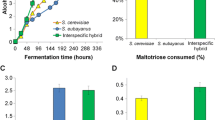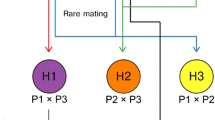Abstract
Hybridization of yeasts allows whole-genome modifications that can be exploited to obtain global improvements in industrial traits, such as those involved in the winemaking industry. In our work we applied direct mating to achieve the construction of hybrids and we subsequently applied these hybrids in fermentation trials under stressful conditions, in order to select hybrid strains with improved technological traits. Five hybrids, obtained from six parental strains by direct spore conjugation, were validated through PCR amplification of highly variable minisatellite-containing genes; the validation phase also revealed three meiotic derivative strains, characterized by contracted number of repeats. Analysis of the mating-type locus in the homozygous spore progeny of parental strains provided useful insights into the understanding of hybridization yields and unveiled some irregularities in yeast autodiploidization mechanism. The fermentative trials were followed by chemical analysis; afterwards principal component analysis allowed the metabolic footprinting of wine yeasts and the selection of the two best industrial candidates, which display superior phenotypes in fermentative fitness and secondary metabolite production, respectively.



Similar content being viewed by others
References
Bisson LF (1999) Stuck and sluggish fermentations. Am J Enol Vitic 50:107–119
Monteiro FF, Trousdale EK, Bisson LF (1989) Ethyl carbamate formation in wine: use of radioactively labeled precursors to demonstrate the involvement of urea. Am J Enol Vitic 40:1–8
Bell SJ, Henschke PA (2005) Implications of nitrogen nutrition for grapes, fermentation and wine. Aust J Grape Wine Res 11:242–295
Lehtonen P (1996) Determination of amines and amino acids in wine—a review. Am J Enol Vitic 47:127–133
Da Silva T, Albertin W, Dillmann C, Bely M, la Guerche S, Giraud C, Huet S, Sicard D, Masneuf-Pomarede I, de Vienne D, Marullo P (2015) Hybridization within Saccharomyces genus results in homoeostasis and phenotypic novelty in winemaking conditions. PLoS One 10:e0123834
Pretorius IS (2000) Tailoring wine yeast for the new millennium: novel approaches to the ancient art of winemaking. Yeast 16:675–729
Santos CNS, Stephanopoulos G (2008) Combinatorial engineering of microbes for optimizing cellular phenotype. Curr Opin Chem Biol 12:168–176
Marullo P, Bely M, Masneuf-Pomarede I, Aigle M, Dubourdieu D (2004) Inheritable nature of enological quantitative traits is demonstrated by meiotic segregation of industrial wine yeast strains. FEMS Yeast Res 4:711–719
Lander E, Schork N (1994) Genetic dissection of complex traits. Science 265:2037–2048
Steinmetz LM, Sinha H, Richards DR, Spiegelman JI, Oefner PJ, McCusker JH, Davis RW (2002) Dissecting the architecture of a quantitative trait locus in yeast. Nature 416:326–330
Winge Ö, Laustsen O (1938) Artificial species hybridization in yeast. Comptes Rendus des Travaux du Laboratoire Carlsberg, Série Physiologique 22:235–245
Steensels J, Snoek T, Meersman E, Nicolino MP, Voordeckers K, Verstrepen KJ (2014) Improving industrial yeast strains: exploiting natural and artificial diversity. FEMS Microbiol Rev 38:947–995
Bellon JR, Eglinton JM, Siebert TE, Pollnitz AP, Rose L, de Barros Lopes M, Chambers PJ (2011) Newly generated interspecific wine yeast hybrids introduce flavour and aroma diversity to wines. Appl Microbiol Biotechnol 91:603–612
Oda Y, Ouchi K (1990) Hybridization of Bakers’ yeast by the rare-mating method to improve leavening ability in dough. Enzyme Microb Technol 12:989–993
Nakazawa N, Okawa K, Sato T, Enei H, Harashima S (1999) Mass mating method in combination with G418- and aureobasidin A-resistance markers for efficient selection of hybrids from homothallic strains in Saccharomyces cerevisiae. J Biosci Bioeng 88:468–471
Hammond JRM, Eckersley KW (1984) Fermentation properties of brewing yeast with killer character. J Inst Brew 90:167–177
Javadekar VS, SivaRaman H, Gokhale DV (1995) Industrial yeast strain improvement: construction of a highly flocculent yeast with a killer character by protoplast fusion. J Ind Microbiol 15:94–102
Romano P, Soli MG, Suzzi G, Grazia L, Zambonelli C (1985) Improvement of a wine Saccharomyces cerevisiae strain by a breeding program. Appl Environ Microbiol 50:1064–1067
Steensels J, Meersman E, Snoek T, Saels V, Verstrepen KJ (2014) Large-scale selection and breeding to generate industrial yeasts with superior aroma production. Appl Environ Microbiol 80:6965–6975
Querol A (2003) Adaptive evolution of wine yeast. Int J Food Microbiol 86:3–10
Birchler JA, Yao H, Chudalayandi S (2006) Unraveling the genetic basis of hybrid vigor. Proc Natl Acad Sci USA 103:12957–12958
Diezmann S, Dietrich FS (2009) Saccharomyces cerevisiae: population divergence and resistance to oxidative stress in clinical, domesticated and wild isolates. PLoS One 4:e5317
Borneman AR, Desany BA, Riches D, Affourtit JP, Forgan AH, Pretorius IS, Egholm M, Chambers PJ (2011) Whole-genome comparison reveals novel genetic elements that characterize the genome of industrial strains of Saccharomyces cerevisiae. PLoS Genet 7:e1001287
Giudici P, Solieri L, Pulvirenti AM, Cassanelli S (2005) Strategies and perspectives for genetic improvement of wine yeasts. Appl Microbiol Biotechnol 66:622–628
De Vero L, Giudici P (2011) Selection of yeast with impaired reduction of sulphates and sulphites in wine production without SO2. Ind Delle Bevande 234:14–22
Mezzetti F, De Vero L, Giudici P (2014) Evolved Saccharomyces cerevisiae wine strains with enhanced glutathione production obtained by an evolution-based strategy. FEMS Yeast Res 14:977–987
Gobbi M, De Vero L, Solieri L, Comitini F, Oro L, Giudici P, Ciani M (2014) Fermentative aptitude of non-Saccharomyces wine yeast for reduction in the ethanol content in wine. Eur Food Res Technol 239:41–48
Solieri L, Verspohl A, Bonciani T, Caggia C, Giudici P (2015) Fast method for identifying inter- and intra- species Saccharomyces hybrids in extensive genetic improvement programs based on yeast breeding. J Appl Microbiol 119:149–161
Johnston JR, Baccari C, Mortimer RK (2000) Genotypic characterization of strains of commercial wine yeasts by tetrad analysis. Res Microbiol 151:583–590
Solieri L, Antúnez O, Pérez-Ortín JE, Barrio E, Giudici P (2008) Mitochondrial inheritance and fermentative: oxidative balance in hybrids between Saccharomyces cerevisiae and Saccharomyces uvarum. Yeast 25:485–500
Huxley C, Green ED, Dunham I (1990) Rapid assessment of S. cerevisiae mating type by PCR. Trends Genet 6:236
Giudici P, Zambonelli C, Kunkee RE (1993) Increased production of n-propanol in wine by yeast strains having an impaired ability to form hydrogen sulfide. Am J Enol Vitic 44:17–21
Mortimer RK, Romano P, Suzzi G, Polsinelli M (1994) Genome renewal: a new phenomenon revealed from a genetic study of 43 strains of Saccharomyces cerevisiae derived from natural fermentation of grape musts. Yeast 10:1543–1552
Sipiczki M (2010) Diversity, variability and fast adaptive evolution of the wine yeast (Saccharomyces cerevisiae) genome—a review. Ann Microbiol 61:85–93
Herskowitz I (1988) Life cycle of the budding yeast Saccharomyces cerevisiae. Microbiol Rev 52:536–553
Garcia Sanchez R, Solodovnikova N, Wendland J (2012) Breeding of lager yeast with Saccharomyces cerevisiae improves stress resistance and fermentation performance. Yeast 29:343–355
Klar AJ, Fogel S (1977) The action of homothallism genes in Saccharomyces diploids during vegetative growth and the equivalence of hma and HMα loci functions. Genetics 85:407–416
Verstrepen KJ, Jansen A, Lewitter F, Fink GR (2005) Intragenic tandem repeats generate functional variability. Nat Genet 37:986–990
Li Y-C, Korol AB, Fahima T, Nevo E (2004) Microsatellites within genes: structure, function, and evolution. Mol Biol Evol 21:991–1007
Contreras A, Hidalgo C, Henschke PA, Chambers PJ, Curtin C, Varela C (2014) Evaluation of non-Saccharomyces yeasts for the reduction of alcohol content in wine. Appl Environ Microbiol 80:1670–1678
Kutyna DR, Varela C, Henschke PA, Chambers PJ, Stanley GA (2010) Microbiological approaches to lowering ethanol concentration in wine. Trends Food Sci Technol 21:293–302
Ciani M, Comitini F (2006) Influence of temperature and oxygen concentration on the fermentation behaviour of Candida stellata in Mixed Fermentation with Saccharomyces cerevisiae. World J Microbiol Biotechnol 22:619–623
Ferreira V, Lopez R, Cacho JF (2000) Quantitative determination of the odorants of young red wines from different grape varieties. J Sci Food Agric 80:1659–1667
Remize F, Andrieu E, Dequin S (2000) Engineering of the pyruvate dehydrogenase bypass in Saccharomyces cerevisiae: role of the cytosolic Mg(2+) and mitochondrial K(+) acetaldehyde dehydrogenases Ald6p and Ald4p in acetate formation during alcoholic fermentation. Appl Environ Microbiol 66:3151–3159
Benito Á, Calderón F, Palomero F, Benito S (2015) Combine use of selected Schizosaccharomyces pombe and Lachancea thermotolerans yeast strains as an alternative to the traditional malolactic fermentation in red wine production. Molecules 20:9510–9523
Lippman ZB, Zamir D (2007) Heterosis: revisiting the magic. Trends Genet 23:60–66
Marullo P, Bely M, Masneuf-Pomarède I, Pons M, Aigle M, Dubourdieu D (2006) Breeding strategies for combining fermentative qualities and reducing off-flavor production in a wine yeast model. FEMS Yeast Res 6:268–279
Dettman J, Sirjusingh C, Kohn L, Anderson J (2007) Incipient speciation by divergent adaptation and antagonistic epistasis in yeast. Nature 447:585–588
Zambonelli C, Passarelli P, Rainieri S, Bertolini L, Levi V, Emilia R, Agrarie I, Soða S, Castellari L (1997) Technological properties and temperature response of interspecific Saccharomyces Hybrids. J Sci Food Agric 50:7–12
Wang Q-M, Liu W-Q, Liti G, Wang S-A, Bai F-Y (2012) Surprisingly diverged populations of Saccharomyces cerevisiae in natural environments remote from human activity. Mol Ecol 21:5404–5417
Magwene PM (2014) Revisiting Mortimer’s genome renewal hypothesis: heterozygosity, homothallism, and the potential for adaptation in yeast. Adv Exp Med Biol 781:37–48
Sipiczki M, Romano P, Lipani G, Miklos I, Antunovics Z (2001) Analysis of yeasts derived from natural fermentation in a Tokaj winery. Antonie Van Leeuwenhoek 79:97–105
Sipiczki M, Romano P, Capece A, Paraggio M (2004) Genetic segregation of natural Saccharomyces cerevisiae strains derived from spontaneous fermentation of Aglianico wine. J Appl Microbiol 96:1169–1175
Acknowledgments
We are grateful to Federico Lemmetti for its technical assistance for HPLC analysis and to AEB group for providing the commercial strains used in this study.
Author information
Authors and Affiliations
Corresponding author
Ethics declarations
Conflict of interest
The authors declare that they have no conflict of interest.
Compliance with ethics requirements
This article does not contain any studies with human or animal subjects.
Rights and permissions
About this article
Cite this article
Bonciani, T., Solieri, L., De Vero, L. et al. Improved wine yeasts by direct mating and selection under stressful fermentative conditions. Eur Food Res Technol 242, 899–910 (2016). https://doi.org/10.1007/s00217-015-2596-6
Received:
Revised:
Accepted:
Published:
Issue Date:
DOI: https://doi.org/10.1007/s00217-015-2596-6




